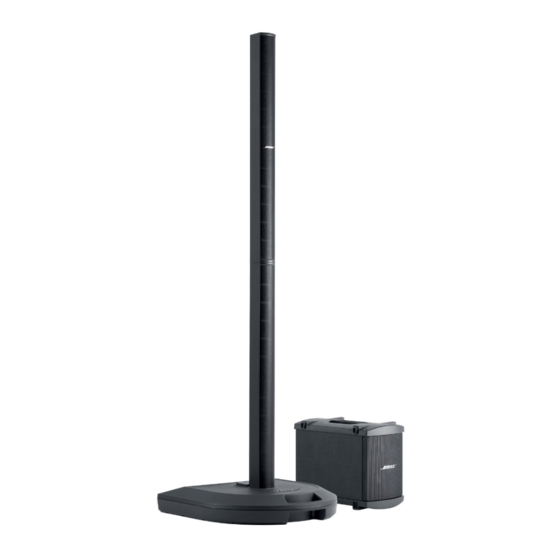Bose Personalized Amplification System Manuale di risoluzione dei problemi - Pagina 21
Sfoglia online o scarica il pdf Manuale di risoluzione dei problemi per Amplificatore Bose Personalized Amplification System. Bose Personalized Amplification System 50.
Anche per Bose Personalized Amplification System: Manuale d'uso (28 pagine)

THEORY OF OPERATION
1.6 Digital Audio
1.6.1 Overview
The PS1 contains a DSP Analog Devices 21065L, U461 [DSP PCB sheet 3, B4] and a one time
programmable micro-controller U342 [microprocessor PCB sheet 2, C3]. The microcontroller
essentially interfaces to all peripherals and communicates the information from/to the peripher-
als to the DSP which contains most of the intelligence of the system. In addition the
microcontroller acts as a watchdog for the DSP, i.e. it will reset the DSP if the DSP chip hangs
up.
1.6.2 Audio Clocking
The audio signal processing is done at 48 kHz which gets created by an internal 12.288 MHz
(= 256*48kHz) oscillator. XTAL431 [DSP PCB sheet 2, B3] and distributed through U434 [B5].
The PS1 can receive SPDIF through the DATA In connector, but this data is received asynchro-
nously to the actual audio data. This is different from most other Bose
®
products, where the
master clock is derived from a digital input (if it exists).
2
Digital audio is transported through an I
S interface (Serial data, Bit clock, Left/Right clock).
U386 [DSP PCB sheet 1, C5] (channel 1/2 A/D) generates the bit clock and the Left/Right clock.
These clocks get buffered through U433 [DSP PCB sheet 2, C5] and routed to U385 [DSP PCB
sheet 1, D4] (channel 3/4 A/D), U387 [B4] (D/A), SPORT 1 (serial port 1) of the DSP, and the
SPDIF transmitter U435 [DSP PCB sheet 2, B7] (Crystal 8046).
1.6.3 Digital to Analog and Analog to Digital Converters (Digital)
Both A/D converters (U385/U386) and the D/A (U387) are hardware configured. U386 is config-
ured as a master and U385 as a slave. The DSP can reset the A/D through FLAG3 and the D/A
through FLAG2. The data is received by the DSP on SPORT1 (serial port 1) channel A (U385)
and channel B (U386). The DSP transmits the audio data again on SPORT1 (serial port 1)
channel A (to the D/A, U387) and channel B (SPDIF transmitter, U435).
1.6.4 SPDIF Interface
The SPDIF output provides the unprocessed audio received from channel 1 and 2. It is basically
a digital copy of the input signals to U386. The audio is sent by the DSP through channel B on
2
SPORT1 in I
S mode and received by U435, a Crystal 8046 SPDIF transmitter. U435 can be
reset by the DSP through FLAG1. U435 generates proper SPDIF signals and these get routed
through a transformer T431, through CN113 back to the Data Out connector on the panel board.
The "Data In" SPDIF input is NOT designed to receive actual audio, but to receive data that is
disguised as a SPDIF bit stream. The SPDIF input is clocked independent from the rest of the
system. The signal is received on the "Data In" connector on the panel board and routed through
CN112 to the DSP board and received by Crystal 8416 SPDIF receiver (U431), which performs
2
clock and data recovery. The data is transferred through an I
S interface to the DSP and re-
ceived through SPORT0 on channel A. The DSP evaluates the data asynchronously. The DSP
can reset U431 through FLAG0 and can monitor the whether the U431 has valid audio through
FLAG8.
21
